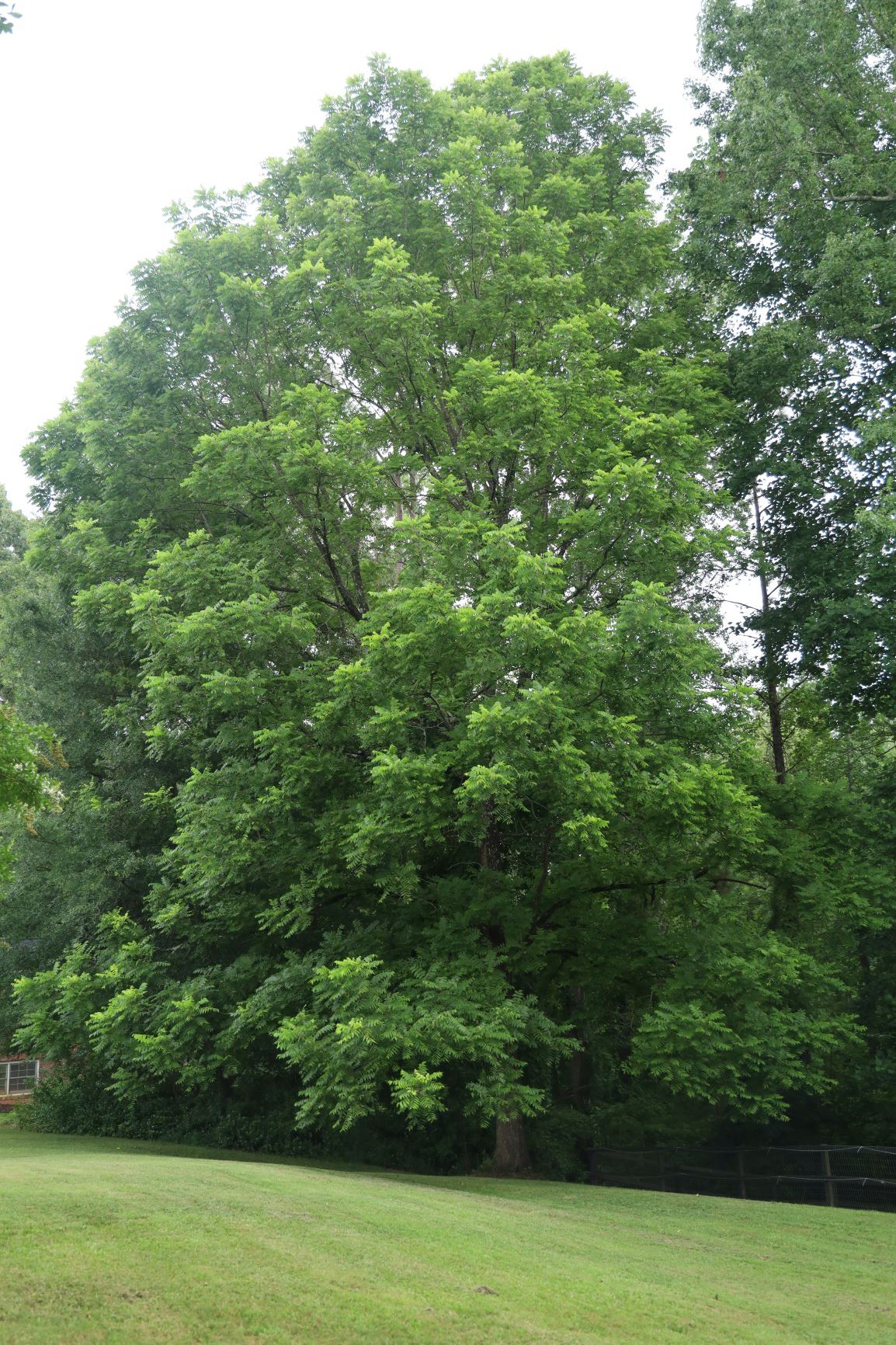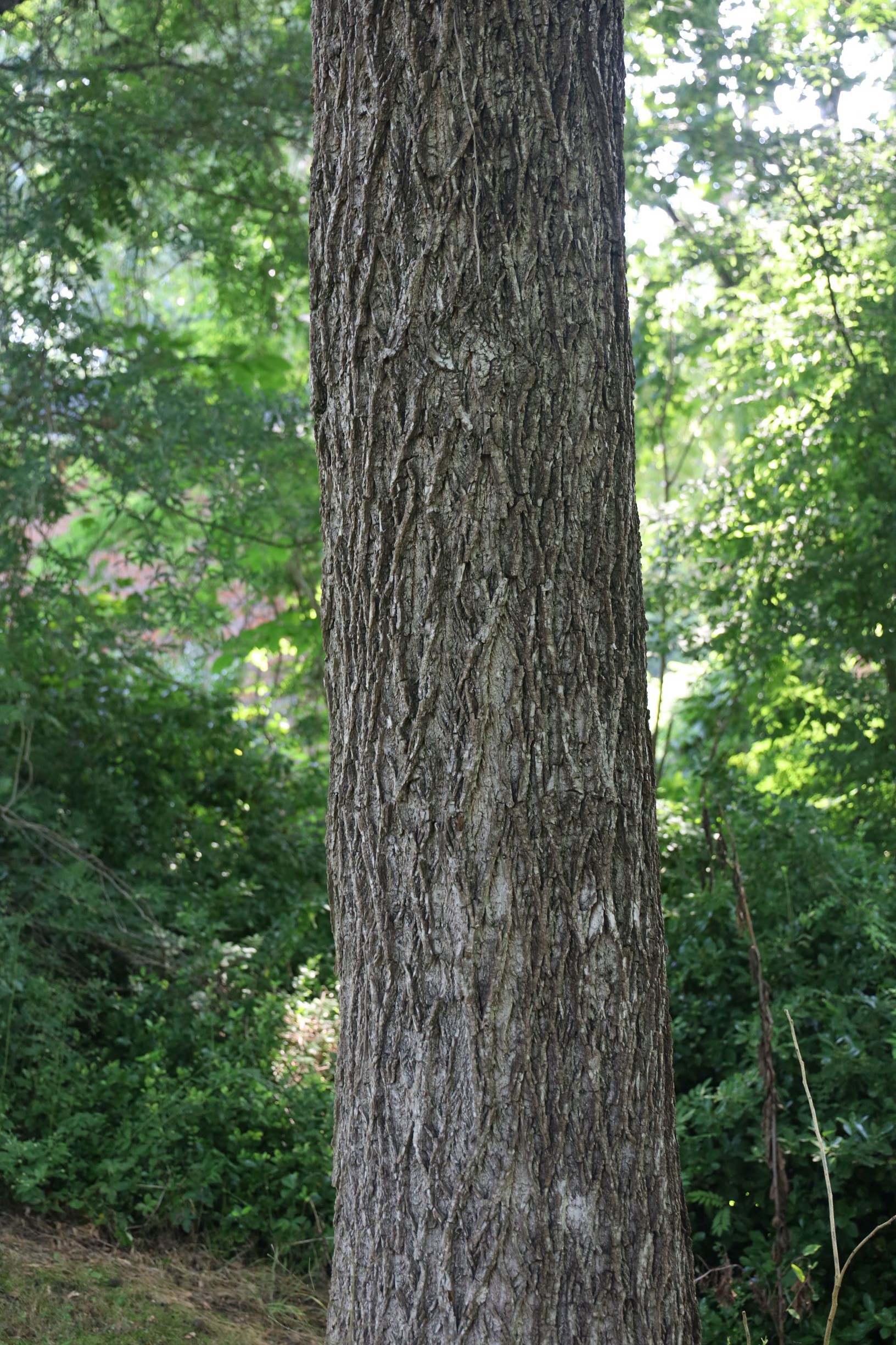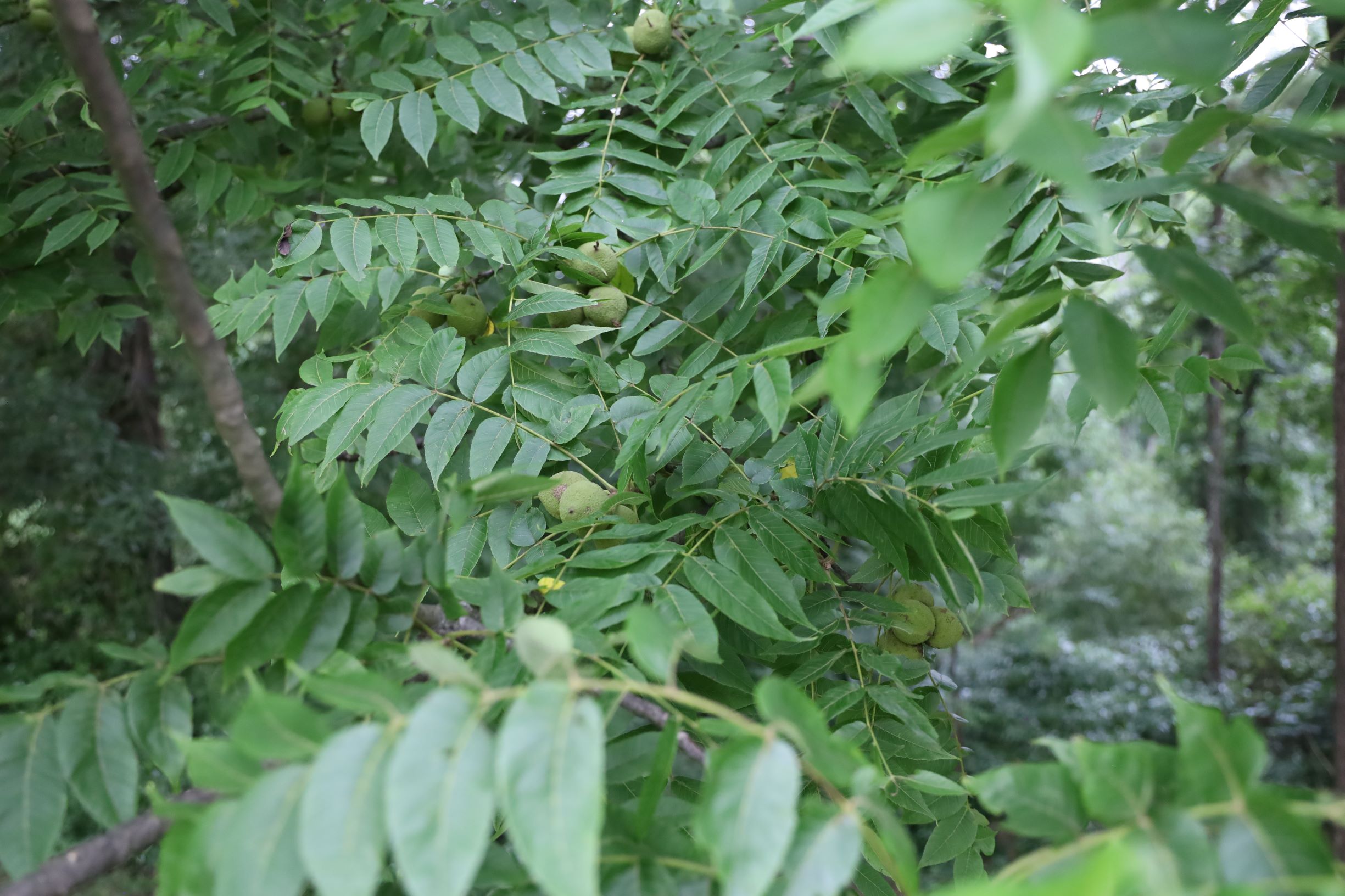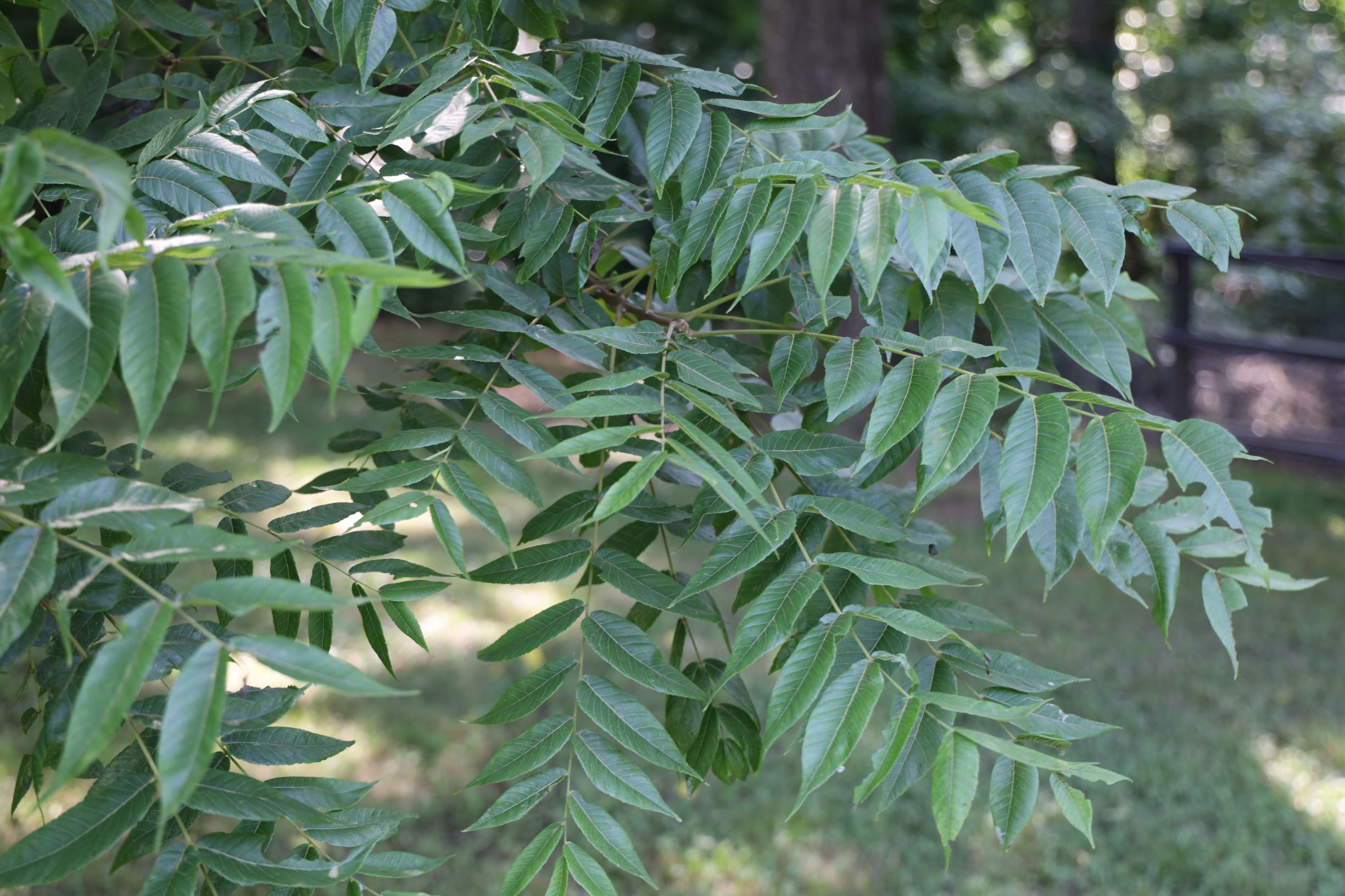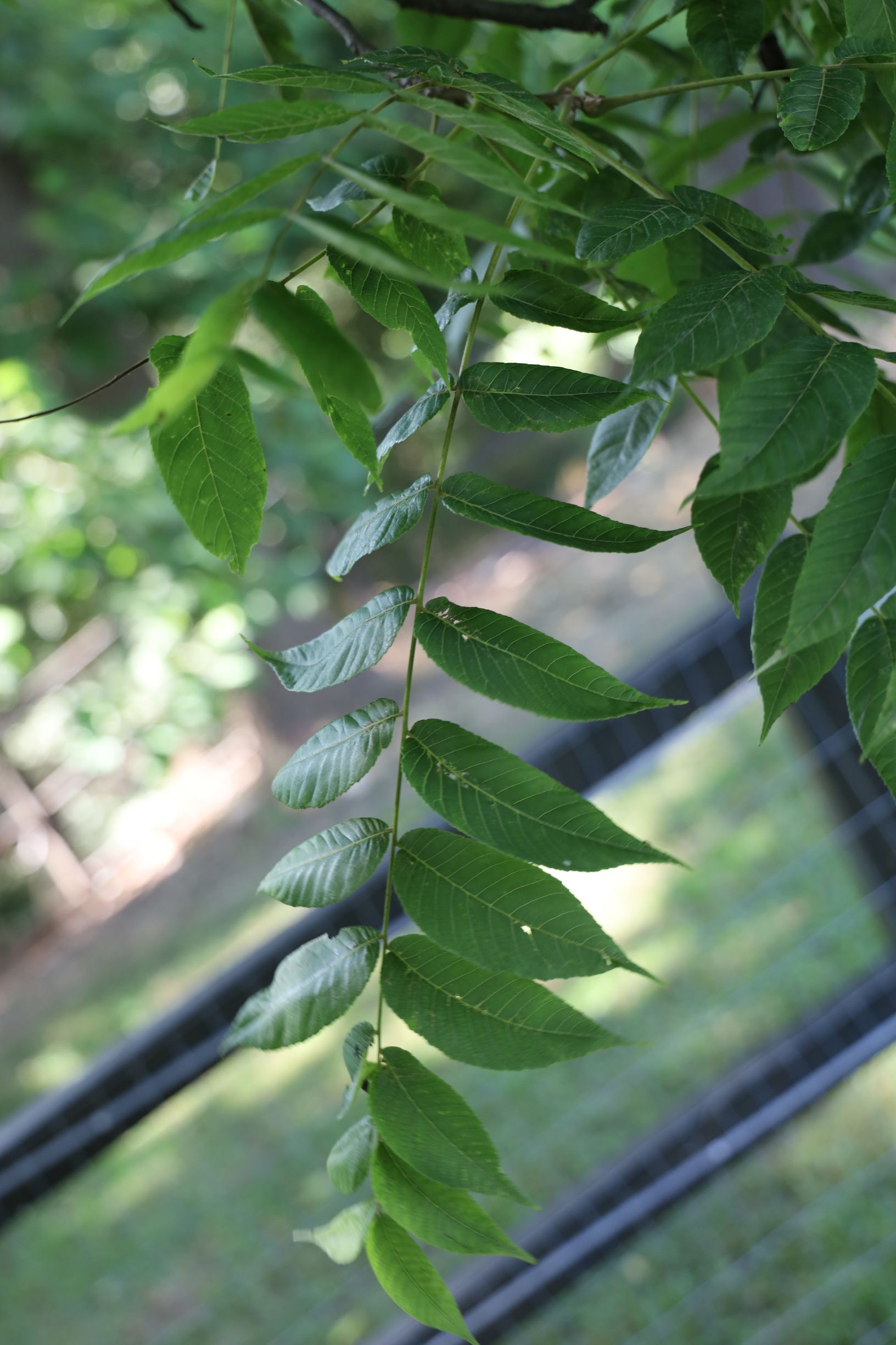Eastern Black Walnut
Juglans nigra
I wasn’t aware of the value of black walnut trees until my father and uncle sold a large black walnut tree off my grandmother’s land for thousands of dollars. Even though I was only ten at the time, I realized then how treasured black walnut trees are. The black walnut is a highly valued tree commercially today and was prized by Native Americans for its medicinal properties. It is a member of the Juglandaceae family, which includes hickory trees and pecan trees (Carya). There are 21 deciduous trees in the Juglans genus which are spread across the world from Southeast Asia to Southeast Europe and North America. The two most economically important species are Juglans nigra, the black walnut, and Juglans regia, the English walnut. The black walnut is grown primarily for its timber (saw wood and veneer), whereas, English walnuts are grown predominately for their edible nuts. Black walnuts are native to North America. Although, most old-growth walnuts have been harvested for timber, a giant specimen still survives on Sauvie Island in Oregon. It is the national champion tree and it stands 112 feet tall with a 7.4-foot diameter trunk.
Description:
Black walnut trees are slow-to-moderate growing deciduous trees, which typically grow 50- to 90-feet tall with comparable spreads. Their shape is usually pyramidal with their spread getting wider with age and their somewhat open symmetrical crown being round to oval.
The enormous, pinnately-compound leaves of the black walnut have 15 to 23 leaflets and are typically 12 to 24 inches long. Each finely toothed leaflet is 2 to 5 inches long and ¾ to 2 inches wide. Leaflets are held in alternately arranged pairs often with no terminal leaflet. This lack of a leaflet at the end of their compound leaves and the aromatic scent released when the leaves are crushed are two good identifying traits of the black walnut tree. Their thick twigs are brown with light to dark brown inner pith. The black walnut’s smooth, sturdy branches are grey to reddish beige. Stems taste bitter when chewed from tannins and turn saliva yellow. The bark is thick and dark brown to greyish-black. Younger trees have smooth matte-finished bark, but trees 30 years or older have deeply fissured bark resembling braided rope forming diamond shapes. The drooping male catkins are 3- to 5-inches long and are found on last year’s growth. Small female flowers appear in clusters at the ends of the current year’s growth. The fruit is a large, globular, 1.5- to 2.5-inch, light-green nut with one-piece hulls. These unique hulls distinguish them from other walnuts and hickories which have hulls divided into segments. The dark brown shell is extremely thick with irregular ridges. The edible seed inside is light brown with a convoluted surface.
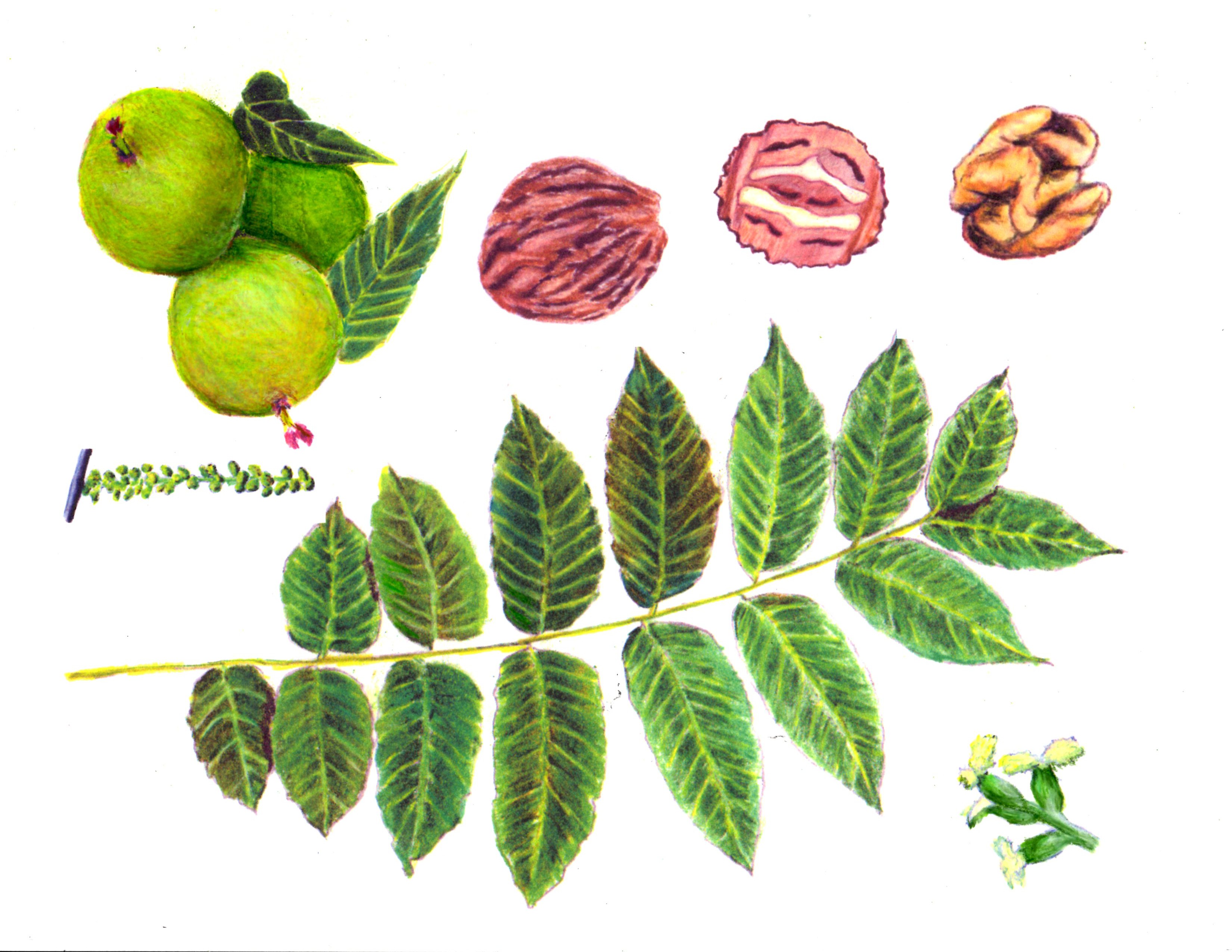
Illustration of the black walnut parts: leaf, male catkin, nuts with husks, nut, kernel, and female flowers. Illustration by Karen M. Johnson
Site Selection/Range/General Culture:
Black walnuts are commonly found in well-drained bottomlands, around old homesites where they were originally planted or in open pastures. These trees range from southern Ontario, westward to eastern South Dakota, southward to eastern Texas, eastward to northern Florida, and northward to Massachusetts. Their range encompasses most of the eastern United States except for the coastal area of the Gulf states. They thrive in Zones 4 thru 9 and when dormant will survive temperatures down to -17-degrees Fahrenheit without any serious damage. Black walnuts prefer a slightly alkaline pH of 6 to 7.2 in a deep, rich, moist, loamy soil. They will tolerate most soils, even drier less fertile soils, but in these conditions, they will grow more slowly and not produce as many nuts.
When planting a black walnut, plant them in a full sun woodland garden setting away from houses, roads, driveways, sidewalks, and patios. This is because they can pose problems from heavy falling nuts or tannins in the husks and leaves staining surfaces.
Irrigation:
Black walnuts are tough, resilient trees. Water your saplings thoroughly when planted, then water once a week during the growing season for the next two years. Each time you water allow the soil to dry around the root ball between waterings. As a rule of thumb, walnuts need 1 to 1.5 inches of rain per week, but once the young trees start to bare nuts at 5 to 7 years of age, they will need deep watering during the 5th to 7th week after blossom to maximize top-quality nut growth. A drought situation during this period will cause the nuts to not fill out their shells properly.
It was thought for years that established trees rarely need supplemental irrigation, but new research shows that nut production and tree growth are markedly complimented by regular watering during the growing season.
Fertilization:
No fertilizer is needed the first year after planting a young walnut tree. Weed suppression around the young trees is more important since the weeds will compete for nutrients already present in the soil. Starting the second year, apply 2 ounces of 15-15-15 or 20-10-10 granular fertilizer in the spring and again in the summer. Spread the fertilizer evenly around the full canopy area and especially at the drip line. Follow this procedure every year until the tree is 6-inch caliper, then increase the rate to 4 ounces of granular fertilizer in the spring and again in the summer.
Each year through your county extension service do a soil analysis to check the macronutrient levels (N-P-K) and pH. Also, have a foliar analysis done to check for any micronutrients that may be lacking such as calcium, zinc, boron or copper. After consulting with your local extension agent or agronomist, apply more fertilizer, pelletized lime, or foliar micronutrient sprays to adjust your levels that are out of whack.
If you prefer not to use chemical fertilizers, well-rotted manure may be spread around the root zone.
Pruning & Training:
Overall, black walnuts are low-maintenance trees that only require minimal pruning each year once established. It is important to initially train your tree to a single, dominant, central leader with no branches of less than a 45-degree angle. Prune the limb structure to be alternately spaced with no branches directly opposite one another as this will improve the strength of the tree over its lifetime. Keep in mind the simple rule of thumb when pruning nut trees that 30% to 50% of the tree should be crown or branches and the rest should be trunk. There may be some small twists or turns in the trunk, but those will normally disappear as the tree matures. Only prune black walnuts in late summer to early fall or else the pruning cuts will ooze sap profusely and weaken the tree.
Pollination:
Black walnuts are monoecious with separate male and female flowers on the same plant. Walnuts are partially self-fertile but produce better with another pollinizer as this will assist with cross-pollination and thus increase nut production. Pollen is transferred by the wind. Late spring frosts may damage flowers causing poor nut production.
Propagation:
Named varieties of walnut trees are normally propagated by vegetative means through budding or grafting onto a rootstock. Grafted trees will usually start bearing 2 to 3 years earlier than seedlings and have better quality nuts. If you opt for the for bareroot or containerized grafted trees, try to plant them in late winter or early spring.
Commercial rootstocks and trees grown for use by home gardeners are grown from seed. When growing from seed make sure to select seeds from trees of superior quality. The nut quality, production level, nut oil content, and geographic location of the parent tree are all important factors to consider when choosing a seed source. The parent trees should not be from more than 200 miles south of the intended planting site. If seeds are chosen from trees farther south, they will be less cold hardy and thus more prone to die back. Seeds should be stratified in a cold, moist place at 41 degrees Fahrenheit or lower for 3 to 4 months for maximum germination. This can be accomplished by planting seeds in deep-cell trays filled with sand and placed in unheated hoop houses in fall or put in plastic baggies of sand then placed in a refrigerator. The seeds will usually germinate in late winter or early spring. Once germinated, transplant the seedlings into individual deep pots filled with seedling soil mix. In early summer, cull through the seedlings and pick the best ones. Then, plant these seedlings in their permanent locations. Stake the young seedlings and give them winter protection the next two winters.
Pest & Disease/Common Problems:
Black walnuts rarely have any problems when in a solitary or non-orchard setting. If proper crop maintenance such as timely fertilizing, pruning, weeding, and watering are applied with the use of disease-free stock most diseases or pest problems can be prevented.
Plant diseases which can affect walnuts are caused by bacterial, fungal, viral, or oomycete pathogens. Some of the major bacterial problems are crown gall and walnut leaf blight. Fungal diseases of walnuts are anthracnose, powdery mildew, oak root fungus, deep bark canker, shallow bark canker, walnut blotch, honey fungus, and branch wilt. The worst viral malady attacking walnuts is blackline disease, which is caused by cherry leaf roll virus, this can be prevented by growing trees on their own roots. Walnut diseases caused by oomycetes are phytophthora root and crown rot. These two diseases can be controlled by planting in well-drained soils and avoiding wetting the tree trunks when irrigating. A new walnut disease that is advancing across the country is thousand cankers disease which is spread by the walnut twig beetle.
Pests which impinge upon walnut trees are aphids, fall webworms, walnut scale, spider mites, codling moth, walnut husk fly, walnut twig beetle, and fire ants. Most of these insect problems can be controlled by spraying Spinosad or beneficial nematodes. An early spring application of horticultural oil when the buds are just starting to swell will help control scale and aphids. It is also important to keep ants off your trees by encircling the trees with sticky boards since ants will protect and farm the aphids for honeydew. Wildlife can also be a pest. Squirrels and crows are prone to eating the nuts. Deer will forage on the tender young twigs and branches.
Common problems with black walnuts are that they are hard to transplant due to their deep tap root and they produce juglone, which acts as a growth inhibitor to some other types of plants such as apples, azaleas, pines and tomatoes. Walnuts are also untidy trees that drop leaves, stems, and nuts through the year which must be raked up to maintain pest and disease control.
Consult your local county extension agent for guidance on controlling any of these problems should they arise.
Harvest & Storage:
Walnuts begin to ripen in late summer, but most won’t fall from the tree until after the first frost. The large green billiard ball-sized walnuts are ready to harvest once they are soft enough to make a small impression on the husks with your thumb. You can wait till the nuts fall to the ground then pick them up or use a long stick and ladder to knock them down. Always wear rubber gloves when harvesting because the tannins in the husks can stain your hands brown for weeks.
The husks usually remain attached after the nuts fall from the tree. The nuts will spoil if the husks are not promptly removed. This difficult task can be accomplished by several different methods: removing the husks by hand, grinding them under your boots on a paved surface, or even driving your vehicle over them repeatedly. Don’t gather any nuts that have mostly black husks because these may be diseased, but ones with a few black spots are fine.
After all the husks are removed, spread the nuts out in a single layer on a screen or concrete surface in a cool dry place for three weeks to let them cure. At the end of three weeks, sample some of the nuts. The nutmeat should be crunchy, not soft or mushy. Also, test the nuts by dropping them into a bucket of water. Discard the ones that float because they may not be fully filled out.
Black walnuts have a high fat content and thus go rancid quickly. For the best long-term storage, store the unshelled nuts in a cool dark location. They will keep for up to a year or more once dried in their shells. Cracking the nuts can be much more difficult than shelling English walnuts. For this tedious project, use a hammer and towel or a vise to remove the shells. There is also a specialized black walnut cracker on the market. The nutmeat can be kept for up to a week if refrigerated in plastic baggies or frozen in baggies they will last up to six months.
Culinary Uses:
The taste of black walnuts is stronger and fruitier than English walnuts. It may be wise to mix them with milder nuts because of their intense flavor. The kernels can be eaten out of hand or used as a topping to add richness to many dishes such as salads or ice creams. The delicious nuts can be used to make a myriad of baked goods such as breads, pastries, cakes, candies, and baklava. Unripe nuts can be pickled in vinegar or be used to make liqueurs. Nuts can be pressed for their oil which is used in salad dressings and in general cooking applications. The nuts can be finely ground into a meal, which then can be used in baking. The nut shells can be ground and used as a spice. The leaves can be dried and used to brew tea. Black walnut trees can be tapped like sugar maples in the spring. The sweet sap can be consumed raw, dried to make sugar, or concentrated by cooking to make syrup.
Nutritional Benefits:
We have all heard about the benefits of eating walnuts for brain and heart health, but there are many other nutritional benefits to consuming black walnuts, which are packed with micro-nutrients, vitamins and other helpful compounds. Black walnuts are loaded with the minerals including manganese, copper, phosphorus, and magnesium. The nuts are also high in zinc and selenium. From a vitamin standpoint, walnuts are an outstanding source of vitamins such as vitamin K, vitamin C, vitamin E, vitamin B1, vitamin B2, vitamin B3, and folate. The nuts are also especially high in vitamin B5 and vitamin B6. The husks can also be used to extract Vitamin C.
Black walnuts are also rich in antioxidants, polyphenols, and melatonin. The quinone compound present in black walnuts, plumbagin, has been found to have antimalarial, neuroprotective, and anticancer properties in scientific studies. Plumbagin has been shown to inhibit the growth of prostate, lung, and, breast cancer cells in Chinese medical studies. An omega-3 fatty acid known as ALA or alpha-linolenic acid in black walnuts protects against coronary heart disease. Diets including walnuts have been found to lessen LDL cholesterol thus reducing blood pressure and the risk of heart attack. The astringent properties of tannins in leaves and husks of black walnuts are helpful in treating skin maladies like acne, eczema, and poison ivy rashes.
Juglone, the compound present in most parts of the plant is toxic to parasitic worms and can be used to expel them from the digestive system. This same compound also has antifungal properties. The juice of green husks was used in folk medicine for ages to treat the fungal infection ringworm. Preparations sold today use ground walnut husks to treat other fungal infections such as candida. Juglone has also exhibited strong antibacterial activity in studies and shows promise in treating Staphylococcus infections.
Native American Uses:
Native peoples had many uses for the black walnut tree. The Comanche and Delaware used the juice of ground leaves and husks to treat areas affected by ringworm fungus. Both the Iroquois and Cherokee used the ground bark as an analgesic. The Iroquois made a poultice of bark for headaches and the Cherokee chewed black walnut bark for toothaches. The bark is somewhat poisonous so caution is recommended in its use. An infusion of the root bark was used by the Rappahannock as an antidiarrheal to ward off dysentery. The Houma and Oklahoma tribes made concoctions from sap and pulverized husks to cure skin inflammations. The Houma also made a decoction from crushed leaves to remedy high blood pressure. Several tribes including the Kiowa used a decoction of root bark to kill parasitic worms.
Many tribes used walnuts as a food source. Crushed nuts were used to make soups, hot beverages, breads or eaten raw mixed with honey. Crushed nutmeats were also added to corn pudding or mixed with mashed potatoes. The Chippewa and Cherokee made brown and black dyes from the husks or roots. The green husks were used by some tribes as a poison in lakes to stun and catch fish. The Delaware and Iroquois used crushed leaves mixed with nutmeat oil and bear grease as an insecticide to deter mosquitos and fleas. The Cherokee fashioned the attractive wood into furniture, gunstocks and ornately carved decorations.
Ornamental Uses:
Black Walnut trees make an attractive, stately addition to any landscape, but one must consider their placement near other plantings due to their production of the toxic compound, juglone. This problem with juglone can be solved by building raised beds for your other plants or using plants that are immune to it.
Plant black walnuts clear of any structures, driveways, sidewalks or parking lots because they have tannins in their leaves and husks which will stain these surfaces. The possibility of large nuts dropping on roofs and cars must also be taken into consideration. These trees can make excellent shade trees but are rarely chosen by landscape architects because they are some of the last trees to leaf out in spring and the first to drop leaves in the fall.
Other Uses:
Black walnut wood is highly prized for its rich dark color, durability, and ease of working. It is traditionally used for cabinets, gunstocks, coffins, flooring, furniture, and many other wood products. Walnut wood is used as a thin veneer or as solid wood. Walnut bark has been used in tanning hides for leathercraft and as a tooth cleaner. Dried walnut leaves can be mixed with straw to make an insect repellant.
Walnut husks are full of tannins and have been boiled down to make dark brown hair dye or textile dye for years. Husks can also be used to make a rich brown ink when mixed with gum arabic, alcohol and water. The nut shells can be finely ground and used as an adulterant or extender in different types of grain. The ground up nut shells have also been used for an abrasive in sand blasting and to de-frag engine parts after manufacturing. The ground shells have also been used as an anti-skid agent on icy walkways and roads.
Black walnut kernels can be pressed to make an oil for paints, stains, paint thinners, and furniture polishes. Ground kernels can be used as a protein supplement feed for cattle or be used as an additive to general livestock feeds.
Commercial English walnut growers use high-grafted black walnut rootstocks for their nut crop trees. So, once the English walnut scion starts to wain in nut production, they can harvest the valuable black walnut log for lumber or veneer.
Recommended Varieties/Related Varieties:
Black Walnuts have been bred for better nut production, lumber, and even as an ornamental. ‘Thomas Black’, ‘Victoria’, and ‘Norris’ are varieties bred for superior nut production in the southeast. ‘Lambs Curly’ is a variety that has unique curly grained wood. Whereas, ‘Lacinata’ was selected for landscape use because of its attractive finely dissected foliage.
Black walnut is a native of eastern North America but there are five other walnut varieties found elsewhere in North America. Butternut or white walnut (Juglans cinerea) grows from Georgia northward through Minnesota and on into Canada. It is very cold hardy and was highly valued for its flavor by Native Americans. The Little walnut or nogalito (Juglans microcarpa) is found in Oklahoma, Texas and New Mexico. It is used as an ornamental landscape tree for smaller landscapes since it grows as a large shrub or small tree. The Arizona walnut (Juglans major) is native to Arizona, western New Mexico, and northern Mexico. Arizona walnuts grow in rocky canyons and along rivers. The southern California walnut (Juglans californica) is one of two walnut varieties found in California. The southern California walnut is used as an ornamental tree and for erosion control. The northern California walnut (Juglans hindsii) is planted as a street tree and grown as rootstock for English walnuts which are extensively cultivated in California.
There are 14 other walnut species scattered around the world. The most well-known walnut is the English or Persian walnut (Juglans regia), which is native to western Asia. It was originally introduced into the Mediterranean region around the first century B.C. and has become popular worldwide. The English walnut is the walnut you usually see in baked goods and at Christmas. It is the most widely commercially grown variety for nut production in the walnut family. The English walnut is easier to crack open than the black walnut and has a milder flavor. The Carpathian walnut strain (Juglans regia ‘Carpathian’) originated in the mountainous regions of Poland. It is like the English walnut, but is more cold hardy. Carpathian walnut trees will survive temperatures as low as 30 degrees below zero Fahrenheit. Heartnut (Juglans ailantifolia var. cordiformis) is a native Japanese tree with a 1” heart- shaped nut. Its unusually shaped nut is quite sweet and easy to crack open.
Hickories and pecans are both in the same Juglandaceae family as walnuts.
Hazards & Cautions:
The roots and leaves of black walnuts produce a substance called juglone which has an allelopathic or growth-inhibiting effect on many other plants, especially tomatoes, potatoes, apple trees, and pines, so they are not a good companion plant. Horses can have an allergic reaction to black walnut wood chips if used for bedding. The bark of black walnuts is poisonous if eaten by humans although it can be used in small amounts as medicine. Wear thick rubber gloves, old clothes, and an apron when harvesting or husking black walnuts. The tannins in the husks can stain your hands or clothes brownish-yellow. The staining can last for weeks on your skin and permanently stain your clothing. Also, because of the potential damage or injury from falling nuts and staining, do not plant walnut trees near houses, sidewalks, or parking lots. Some people are allergic to wind blown pollen of the black walnut tree.
References & Related Links:
- Bennett, Chris. Southeast Foraging. Portland: Timber Press, 2015.
- Biggs, Matthew; McVicar, Jekka; and Flowerdew, Bob. Vegetables, Herbs & Fruit: An Illustrated Buffalo, New York: Firefly Books, 2013
- Creasy, Rosalind. Edible Landscaping. San Francisco: Sierra Club Books, 2010.
- Fern, Ken and Fern, Abby. Edible Trees: A Practical and Inspirational Guide from Plants for a Middletown, DE: Pemberton Creative, 2013.
- Hageneder, Fred. The Meaning of Trees. San Francisco: Chronicle Books, 2005.
- Kirkman, L. Katherine; Brown, Claud L. and Leopold, Donald J. Native Tress of the Southeast- An Identification Guide. Portland: Timber Press, 2007.
- Kershner, Bruce; Mathews, Daniel; Nelson, Gil; Spellenberg, Richard. National Wildlife Federation- Field Guide to Trees of North America. New York: Sterling Publishing, 2008.
- Logsdon, Gene. Organic Orcharding: A Grove of Trees to Live In. Emmaus, PA: Rodale Press, 1981.
- McCausland, Jim. Sunset – Western Garden Book of Edibles. Menlo Park, CA: Sunset Publishing, 2010.
- Moerman, David E. Native American Ethnobotany. Portland: Timber Press, 1998.
- Pollock, Michael. Fruit & Vegetable Gardening: The Definitive Guide to Successful Growing. New York: Doling Kimbersley Limited, 2012.
- Russell, Tony. Smithsonian Nature Guide: Trees. New York: DK Publishing, 2012.
- Sternberg, Guy and Wilson, Jim. Native Trees for North American Landscapes. Portland: Timber Press, 2004.
- Zachos, Ellen. Backyard Foraging. North Adams, MA: Storey Publishing, 2013.

